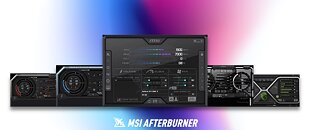MSI Afterburner has been finally updated to a new version, the v4.6.5, bringing support for NVIDIA GeForce RTX 40 series and AMD Radeon RX 7900 series graphics cards. MSI Afterburner has been one of the most popular overclocking and monitoring tools for graphics cards, especially since the EVGA Precision X has been discontinued, but it has hit a snag back in 2022 when the developer was not paid by MSI.
The latest update is a big milestone for Afterburner, as the new version 4.6.5 is a stable release and comes after the Afterburner was not updated in a while due to the fact that the developer Alexey Nicolaychuk, who goes by the name Unwinder over at Guru3D, was not paid by MSI. While there were BETA updates in the meantime, there has not been a stable release since 2019. The new version adds support for both NVIDIA RTX 40 series and AMD Radeon RX 7900 series graphics cards, adds experimental support for Intel's 13th Gen Core CPUs and AMD Ryzen 7000 series CPUs, as well as brings plenty of other fixes.
Update: Unwinder notified us that the previous stable Afterburner 4.6.4 release was published in the end of 2021 (03.12.2021).

Here are the full release notes:
MSI Afterburner Version 4.6.5
View at TechPowerUp Main Site | Source
The latest update is a big milestone for Afterburner, as the new version 4.6.5 is a stable release and comes after the Afterburner was not updated in a while due to the fact that the developer Alexey Nicolaychuk, who goes by the name Unwinder over at Guru3D, was not paid by MSI. While there were BETA updates in the meantime, there has not been a stable release since 2019. The new version adds support for both NVIDIA RTX 40 series and AMD Radeon RX 7900 series graphics cards, adds experimental support for Intel's 13th Gen Core CPUs and AMD Ryzen 7000 series CPUs, as well as brings plenty of other fixes.
Update: Unwinder notified us that the previous stable Afterburner 4.6.4 release was published in the end of 2021 (03.12.2021).

Here are the full release notes:
MSI Afterburner Version 4.6.5
- Added NVIDIA GeForce RTX 40×0 series graphics cards support
- Added voltage control support for GA103 and GDDR6x based versions of NVIDIA GeForce RTX 3060 Ti
- Added AMD RADEON RX 7900 series graphics cards support
- Added total board power monitoring support for AMD RADEON RX 7900 series graphics cards
- Added some future AMD and NVIDIA GPU PCI DeviceIDs to hardware database
- Added Intel Arc GPUs support to hardware monitoring module. Please take a note that Intel Arc GPUs overclocking and tuning is currently not supported due to Intel hardware control API support limitation to x64 applications only
- Added experimental support for Intel 13th generation CPUs
- Added experimental support for AMD Ryzen 7xxx CPUs
- CPU usage data sources in hardware monitoring module have been switched to alternate implementation based on NtQuerySystemInformation(SystemProcessorIdleInformation), because traditional legacy idle time reporting in NtQuerySystemInformation(SystemProcessorPerformanceInformation) is broken in current Windows 11 22H2 builds
- Added workaround for broken fixed fan speed programming API (Overdrive 5 compatible fallback path) for old Overdrive 7 GCN GPUs on 22.5.2 and newer AMD drivers
- Added config file switch for disabling native reliability voltage control API on NVIDIA GeForce GTX 9×0 series graphics cards and forcing legacy P-state 2.0 voltage control API usage on such hardware. Power users may use this switch to bypass voltage control lock on NVIDIA Maxwell series graphics cards on release 515 and newer drivers families
- Improved correction formula parser with data format conversion, rounding and min/max functions support
- Added OCMailbox based bus clock frequency monitoring for Skylake and newer Intel CPUs. Unlike traditional legacy timestamp clock based bus clock frequency estimations, OCMailbox provides support for overclocked BCLK monitoring. Please take a note that access to OCMailbox is blocked by design of OS when HVCI is enabled
- Improved SMART.dll monitoring plugin. Added temperature monitoring support for NVMe devices, including the secondary controller temperature for some Samsung NVMe drives
- Default clock frequency limit of voltage/frequency curve editor window has been extended to 3.5GHz. Please take a note that you may still customize the limits via config file if necessary
- Update server location changed to new URL inside update checking system. Old update server location reached EOL
View at TechPowerUp Main Site | Source






